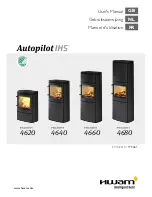
104985 – 104986 – 104986V
DT Istr 104985-104986 – 02/2011 - Rev 11_03/2019
9/32
•
WARNING: accessible parts can reach high temperatures. Keep the appliance out of the reach of children.
•
Should the air vents become partially or totally blocked, stop using the product immediately, tighten the taps
as described and take the stove to an after-sales assistance centre.
•
WARNING: the maximum diameter of the container to be heated is 320 mm.
Do not use containers with
a larger diameter.
•
After a long period of time, check that the rotation of the valve takes place without binding and that the orifices
of the burner tube and the Venturi tube are free of spider webs and spiders' nests.
•
Do not move the appliance during use.
•
Close the gas cylinder valve after using.
ASSEMBLY INSTRUCTION
104985 – 104985D:
Attach the supports (3) to the burner (1) using the screws (2). Securely tighten the
unit and check its stability and robustness.
104986 – 104986V – 104986D – 104986VD:
Attach the supports (3) to the structure (2) using the screws (6) and tighten with
the nut provided (7). After tightening all four supports, take the burner (1) and
attach it to the support (8) by means of the two screws (9).
Repeat this operation on the opposite side, securing the burner to the support (5)
with the screw (9).
INSTRUCTIONS FOR INSTALLING THE APPLIANCE
These operations must be performed in well-ventilated environments and at a good distance from naked flames
or inflammable materials.
1) The stove must be connected to the gas cylinder by means of a rubber hose for LPG in conformity with the
standards of the country in which the stove is to be used.
2) The hose must not be longer than 1.5 m and must be replaced on the basis of the legislation in force in the
country in which the appliance is used.
3) Always use a low-pressure regulator to connect the stove to the gas cylinder. This MAY ONLY be a fixed
setting regulator normalized according to table previously submitted.
4) Use a small gas tank 3 kg (minimum) to 15 kg (maximum).
5) The cylinder should be placed as far as possible from the unit without pulling the tubing.
6) The hose must be attached to the stove and to the regulator, in countries in which connection is permitted
by the user, by GAS-COMPATIBLE CLOSED MESH METAL CLAMPS.
7) Ensure that the hose is not to subjected to twisting by placing the gas cylinder in a suitable position with
respect to the stove.
8) THE HOSE MUST ALWAYS BE REPLACED WHEN IT PRESENTS ABRASIONS OR BURNS.
9) Place the stove on the ground or on the floor, always in a horizontal position. Never place the stove on
surfaces made of wood, plastic or other inflammable materials.
10) DO NOT TRY TO OPERATE THE STOVE WITH METHANE.
11) WARNING: to avoid a dangerous overheating of the gas pipe, DO NOT install the hose by passing it under
or behind the stove but at the side, keeping it away from the cooking area
ATTACK AND EXCHANGE CYLINDER
The gas cylinder should not be dropped or handled carelessly! When the unit is not in use, the cylinder must be
disconnected. Cylinders must be stored outdoors in a vertical position and out of the reach of children. Never
place the cylinder in places where the temperature may exceed 50 °C. Do not place cylinders near open flames
or other sources of ignition.
DO NOT SMOKE NEAR THE CYLINDER.
WARNING:
the cylinder must be changed outdoors and away from any flame or heat source.
For the installation of the cylinder proceed as follows:
1) Close the cylinder valve (4).
2) Check that the valve is closed the stove.
3) ENSURE THAT THERE IS A SEAL ON THE PRESSURE REGULATOR
AND THAT IT IS IN PERFECT CONDITIONS BEFORE ATTACHING THE
REGULATOR ON THE NEW GAS CYLINDER.
4) Attach the regulator (1) to the cylinder.
MOD. 104985 – 104986 – 104986V
5) Insert the rubber tube on the one hand on the receiver cooker (2) and the other on the pressure regulator
and secure with hose clamps (3).
MOD. 104985D – 104986D – 104986VD
5) Screw the crimped tube on one side to the threaded connection of the burner and on the other side on the
pressure regulator.










































